It took me a while to evaluate the Netgear Nighthawk RS700S BE19000 Wi-Fi 7 router.
The router's actual model is RS700, as printed on its underside and shown in the mobile app and web interface. The "S" signifies that it comes with a one-year trial of Netgear Armor.
At $699.99, the router is not wildly expensive like its Orbi cousin, but I wanted to wait for Wi-Fi 7 to be finalized, which happened earlier this month.
Here's the bottom line: The Netgear RS700S is definitely worth the wait and the cost. It's the best Netgear router to date and dethrones the Asus RT-BE96U, which was tested before Wi-Fi 7's certification, as the fastest standalone router by a small margin.
While this Nighthawk RS700S doesn't offer nearly as many features as its Asus counterpart, if you live in a place needing just a single broadcaster, it is an excellent fit, performance-wise and aesthetically. Consider one today!
Dong's note: I first published this post on March 14, 2023, as a new piece and updated it to an in-depth review on January 23, 2024, after thorough hands-on testing.

Netgear RS700S Wi-Fi 7 router: The Nighthawk family’s new elegant and authentic multi-Gigabit member
The Netgear RS700 is a slender verticle box that looks like an elegant, good-sized portable boombox. It's pretty large but not as massive as the Orbi 970. And compared to the bulky Asus RT-BE96U, it sure is a beaut.
There's a good reason behind the large physical size. On the inside, the RS700S houses a heavy heatsink instead of an internal fan. That's a good break away from Netgear's previous bulky design in its Wi-Fi 6 and 6E routers. No moving parts means less maintenance and more longevity.
Other than that, the RS700S is very similar to its main rival, the Asus RT-BE96U—the two share almost the same hardware specs, as shown in the table below.
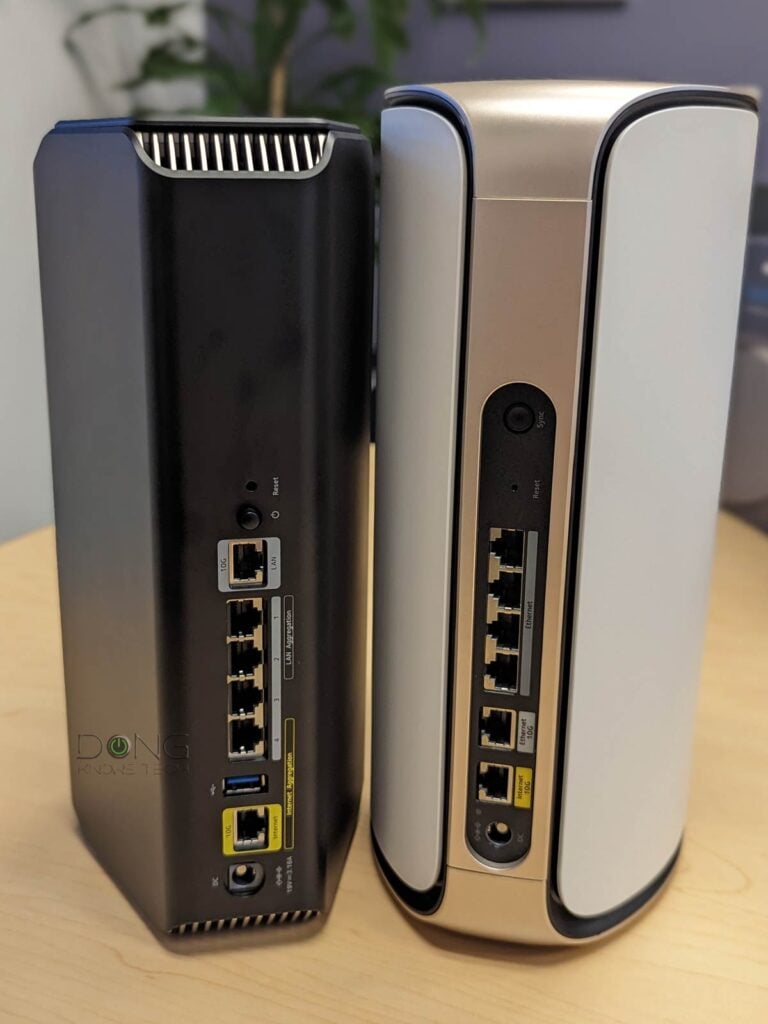
Hardware specifications: Netgear RS700S vs. Asus RT-BE96U
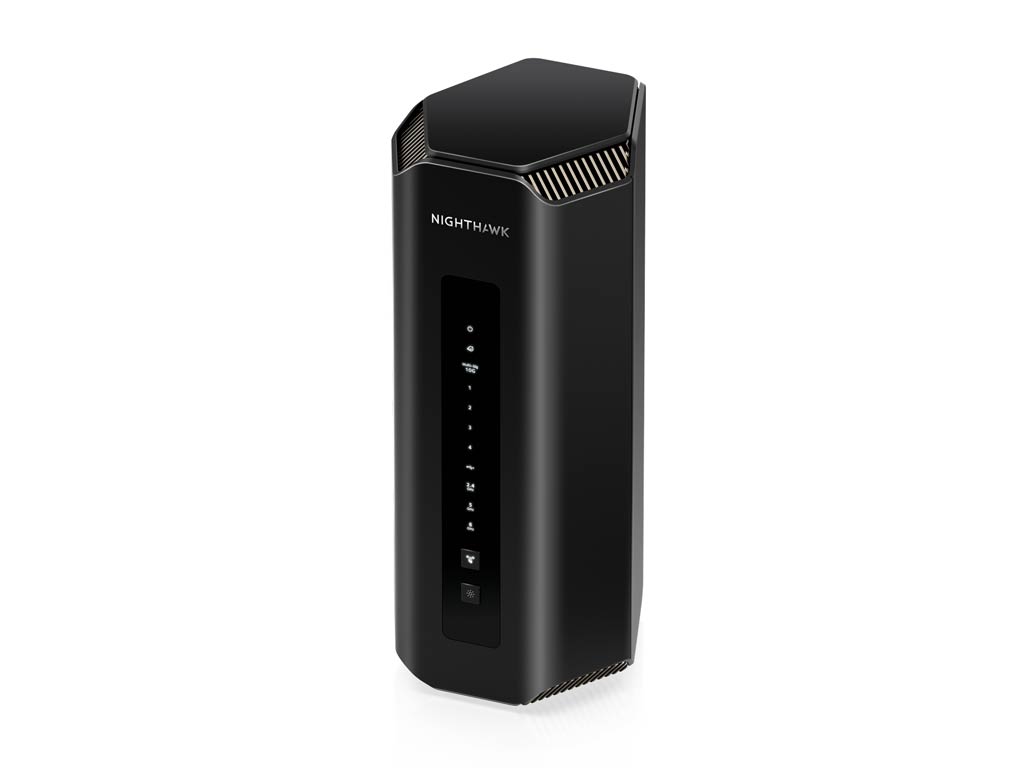 | 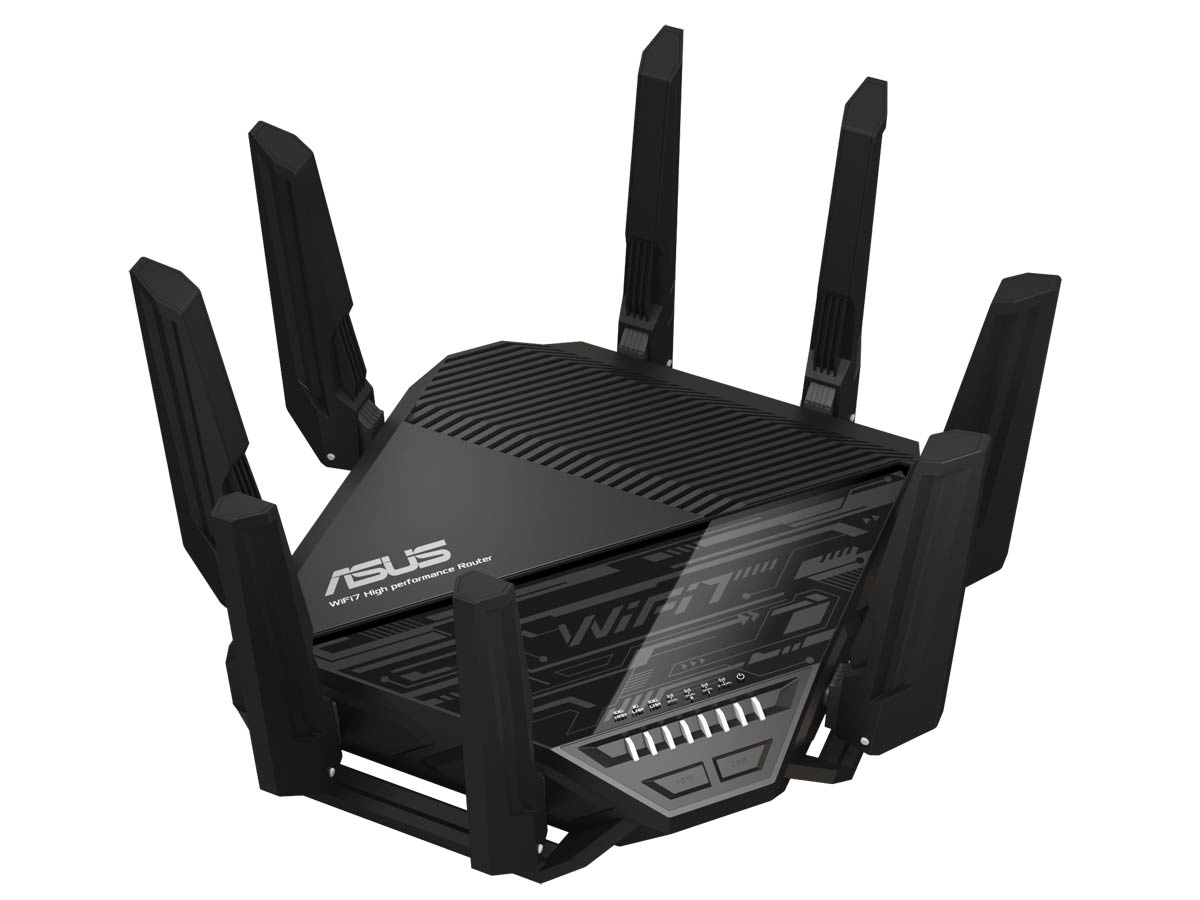 | |
|---|---|---|
| Full Name | Netgear Nighthawk RS700S BE19000 Wi-Fi 7 Router | Asus RT-BE96U BE19000 Wi-Fi 7 Router |
| Model | RS700, RS700S | RT-BE96U |
| Dimensions | 11.09 x 5.59 x 4.88 in (281.70 x 142 x 124.03 mm) | 13.8 x 13.8 x 8.57 in (350.6 x 350.6 x 217.59 mm) |
| Weight | 3.61 lb (1.635kg) | 4.12 lbs (1.87 kg) |
| Wi-Fi Technology | Tri-band BE19000 | |
| QAM Support | 4096-QAM | |
| 5GHz Band Specs (channel width) | 4x4 5GHz BE: Up to 5.8Gbps (20/40/80/160MHz) | |
| 6GHz Band Specs (channel width) | 4x4 BE: Up to 11.5Gbps (20/40/80/160/320 MHz) | |
| 2.4GHz Band Specs (channel width) | 4x4 BE Up to 1.4Gbps (20/40MHz) | |
| Backward Compatibility | 802.11a/b/g/n/ac/ax/axe | |
| Mobile App | Netgear Nighthawk | Asus Router |
| Media Bridge Mode | No | Yes |
| AP Mode | Yes | |
| Network Features | Web User Interface Nighthawk Mobile App Limited free features and settings | Web User Interface Asus Mobile App Asus Core Features |
| Premium Add-on | Netgear Armor ($100/year) Parental Control (70/year) | None (all features are free for life) |
| Mesh-ready | No (Wi-Fi EasyMesh—planned) | Yes (AiMesh) |
| USB Port | 1x USB 3.0 | 1 x USB 3.0 1 x USB 2.0 |
| Gigabit Port | 4x LAN | |
| Multi-Gig Port | 1x 10Gbps WAN 1x 10GGbps LAN | |
| Link Aggregation | Yes (WAN and LAN) | |
| Dual-WAN | No | Yes |
| Processing Power | Quad-core 2.6GHz CPU, 512MB Flash, 2GB RAM | Quad-core 2.6GHz CPU, 256MB Flash, 2GB RAM |
| Power Intake | 120V | 110-240V |
| Power Consumption (per 24 hours) | ≈ 375 Wh (as tested) | |
| Firmware (at review) | V1.0.7.82 | 3.0.0.6.102_32872 |
| Release Date | July 7, 2023 | August 18, 2023 |
| Price (at Launch) | $699.99 | $699.99 |
The two share lots of similarities, including, interestingly, real-world power usage.
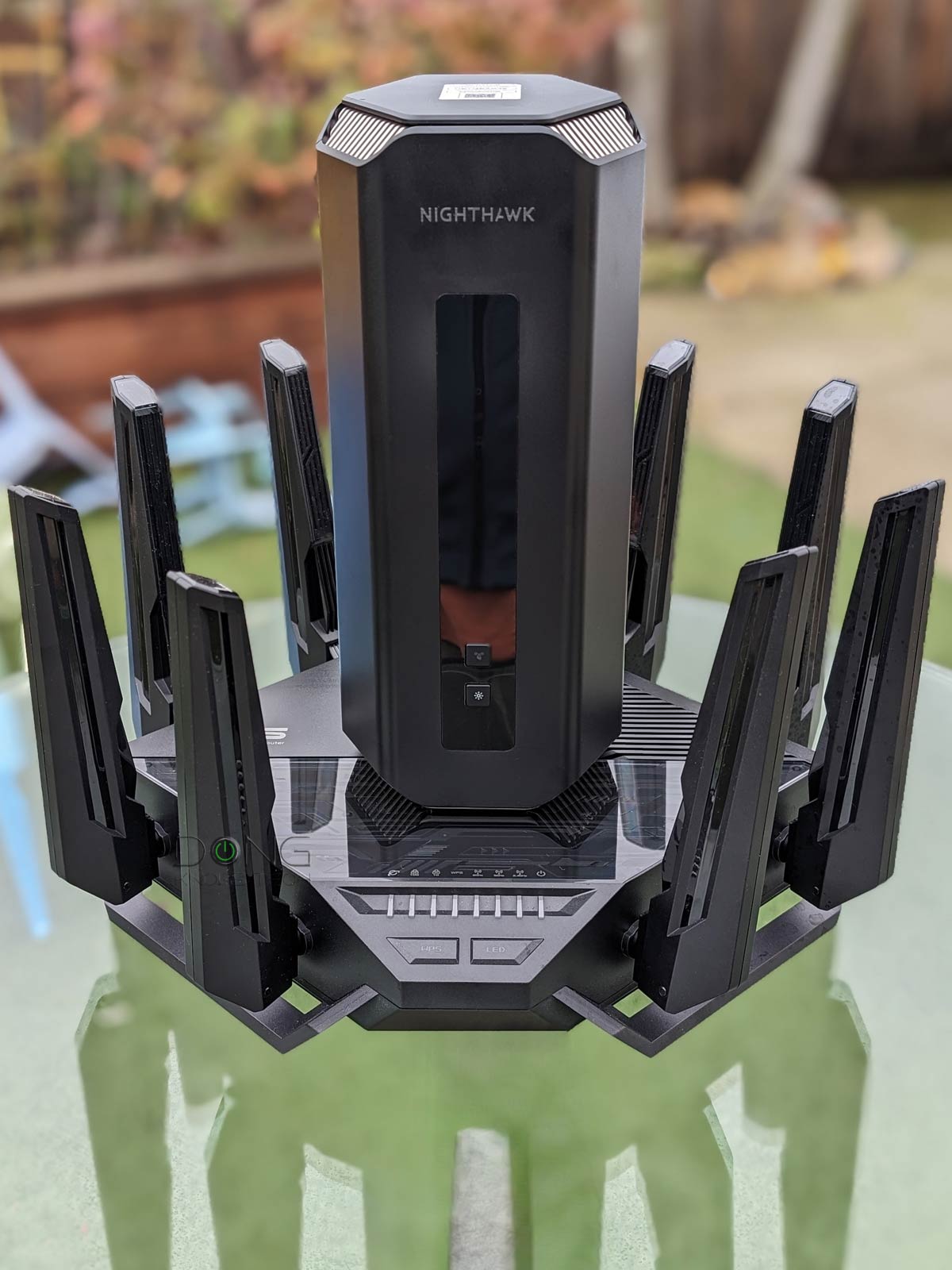
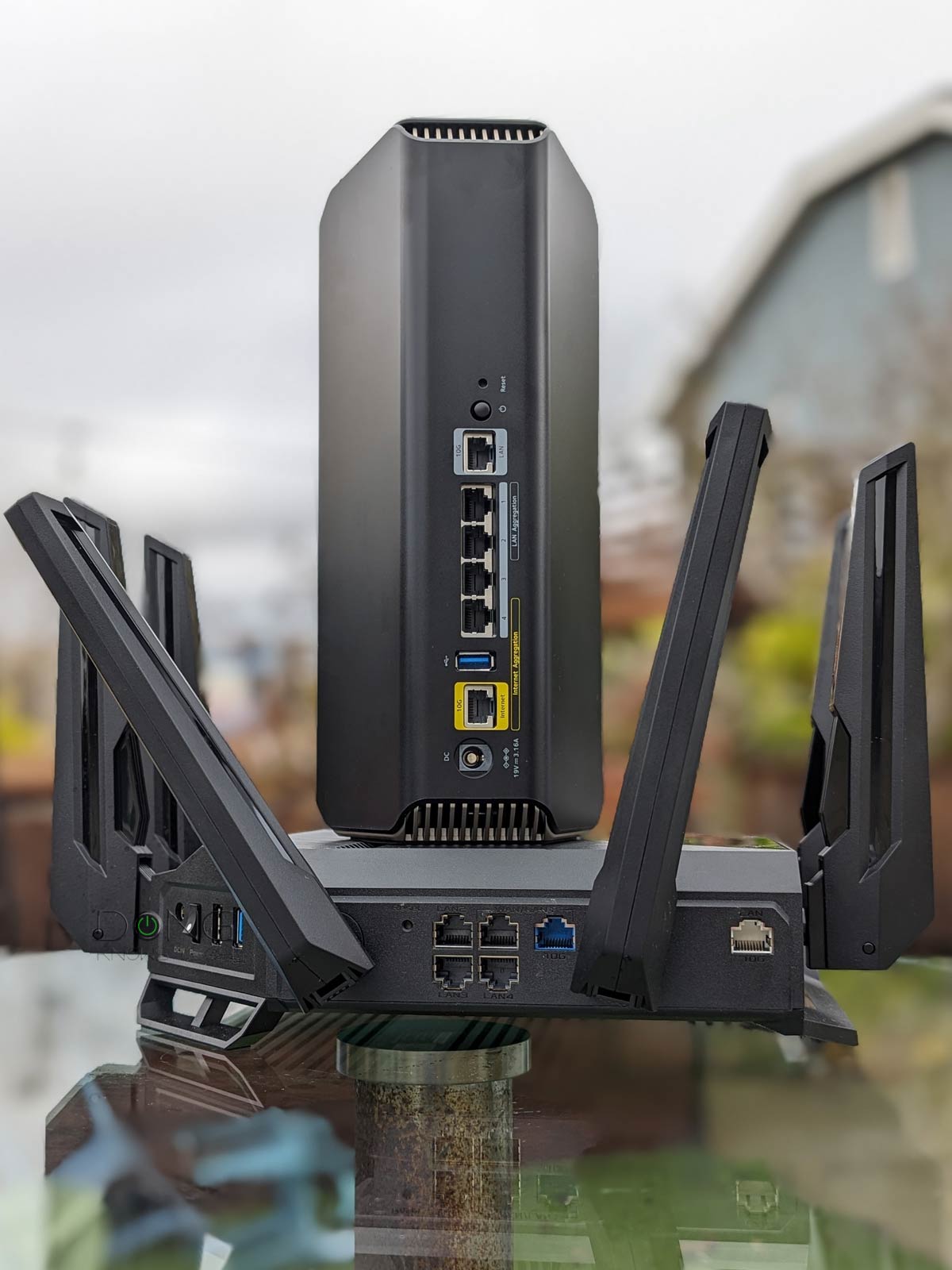
First router with two 10Gbps ports
It's hard to believe, but the RS700S is Netgear's first standalone router with two 10Gbps ports. For a couple of years, I've maintained a long list of existing routers from other networking vendors with two or even more Multi-Gig ports. But better late than never.
Unfortunately, unlike the Wi-Fi 7 Orbi, the new router doesn't go all Mulit-Gig. Instead, it still has four Gigabit LAN ports. Additionally, they have a USB 3.0 (a.k.a. USB 3.2 Gen 1) port for network-attached storage when hosting an external drive.
If you wonder why it doesn't feature a faster USB standard, such as USB 3.2 Gen 2 (10Gbps), to accommodate its 10Gbps ports and faster Wi-Fi speeds, that's the Wi-Fi chip's fault. Per Netgear, the RS700S is powered by Broadcom BCM67263/26 Wi-Fi 7 chips, first announced in April 2022.
Still, two 10Gbps is a fundamental change from having just one. The RS700S is the first from Netgear capable of delivering a true 10Gbps wired connection out of the box. On top of that, throw in a Multi-Gig switch, and the router will turn your entire home network multi-Gigabit.
Netgear Nighthaw RS700S: Detail photos

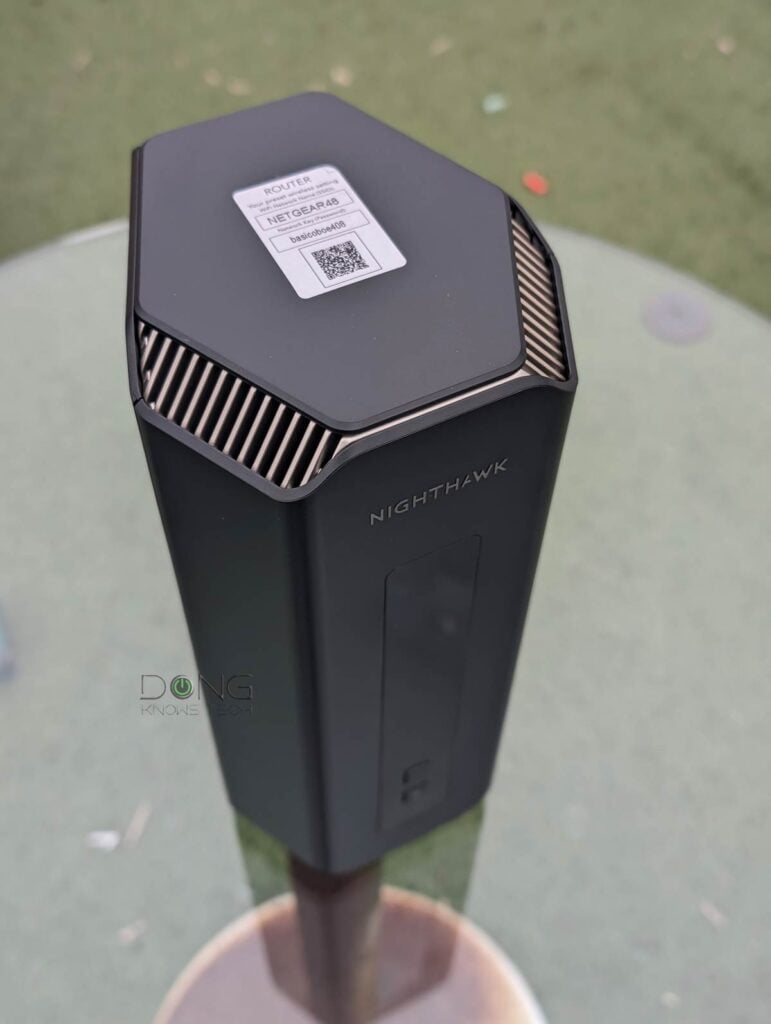
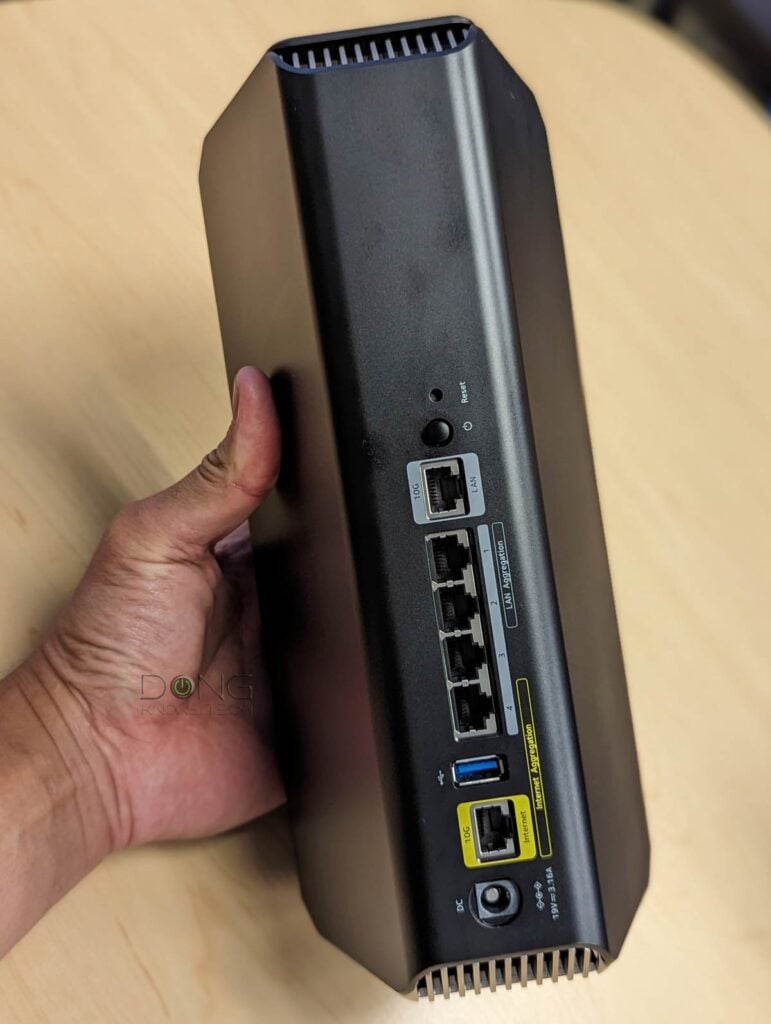
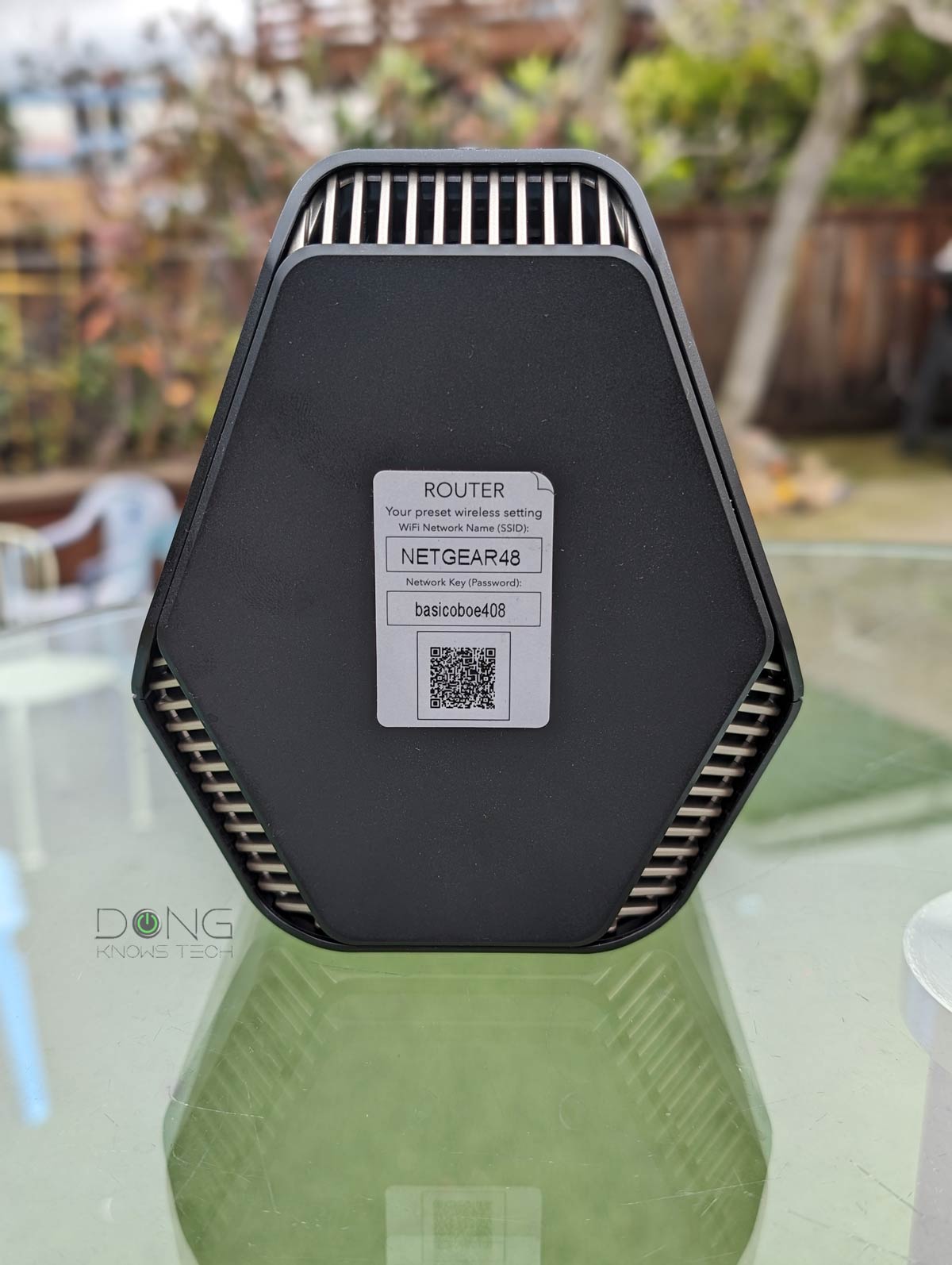
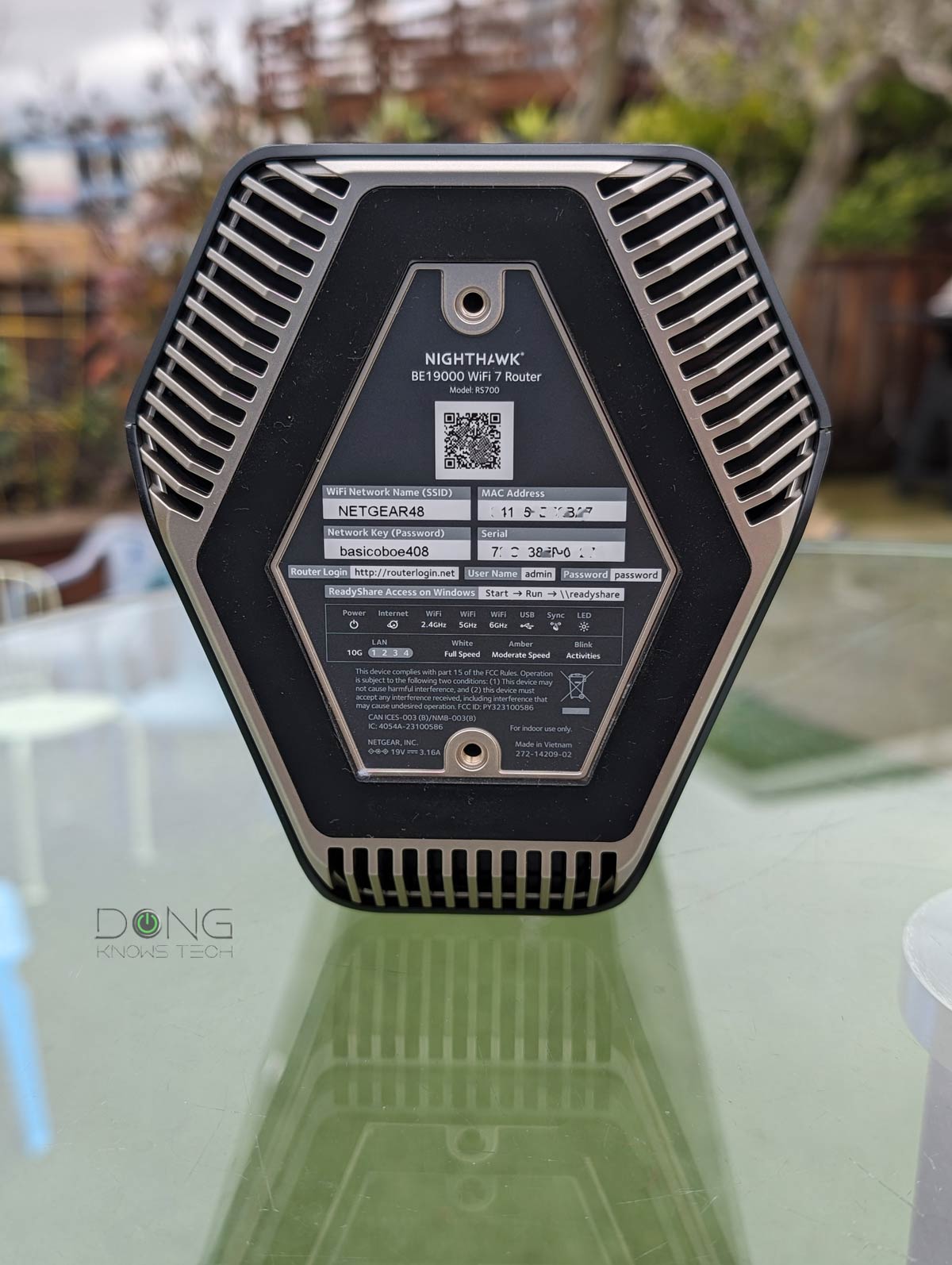
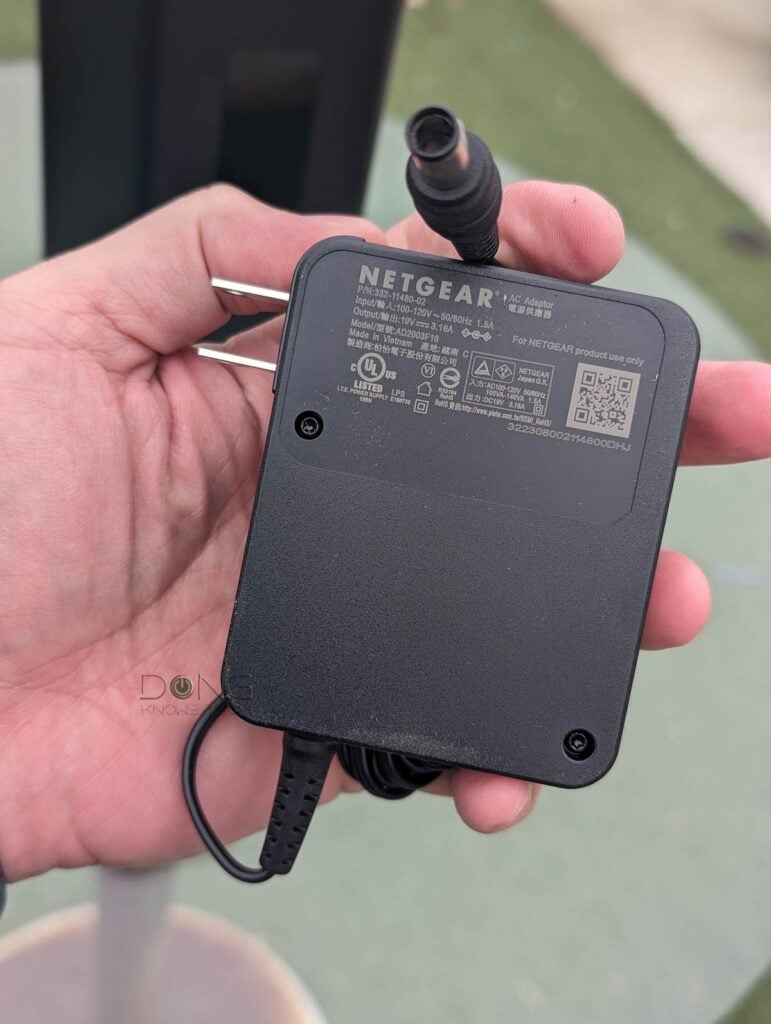
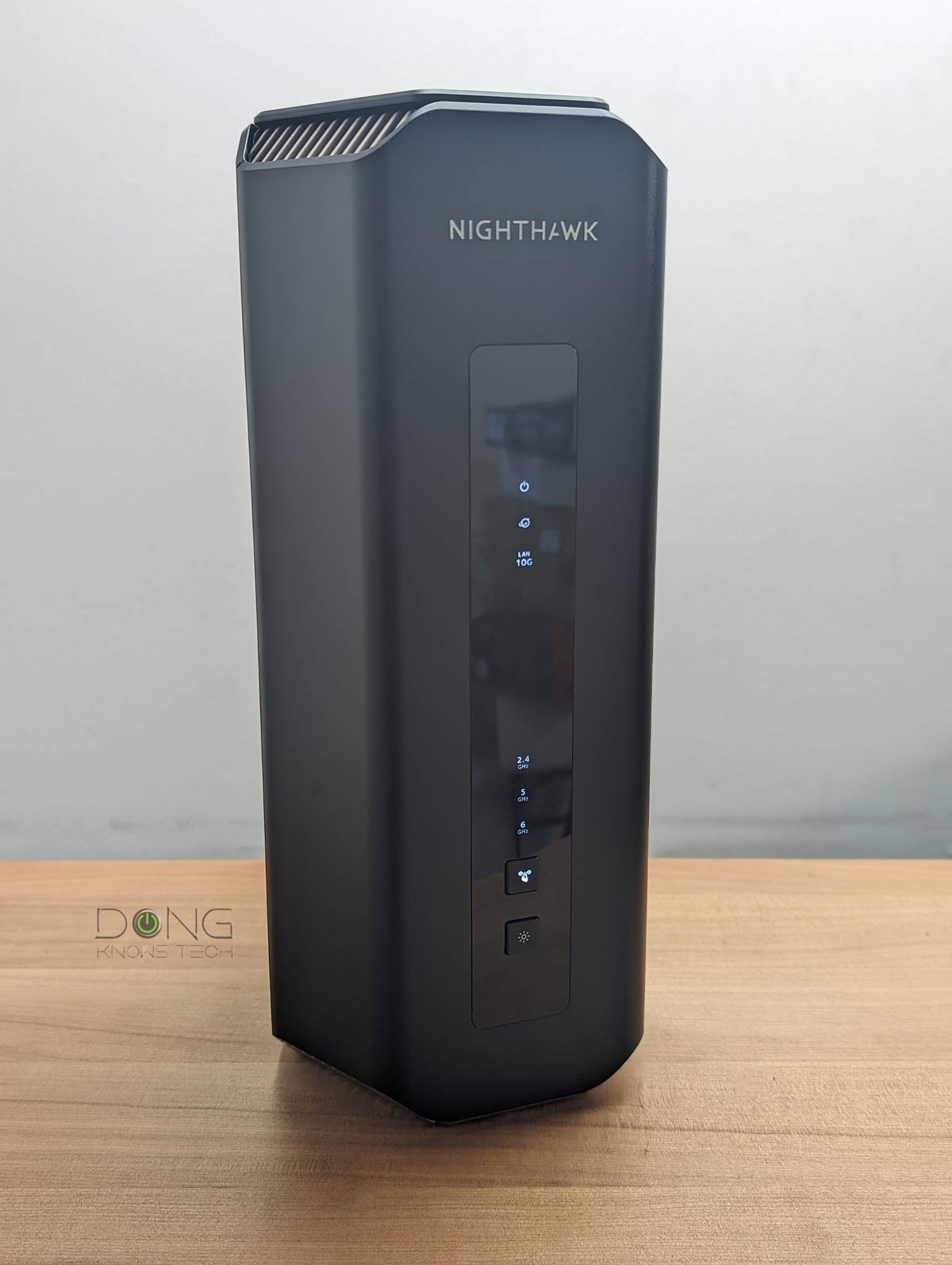
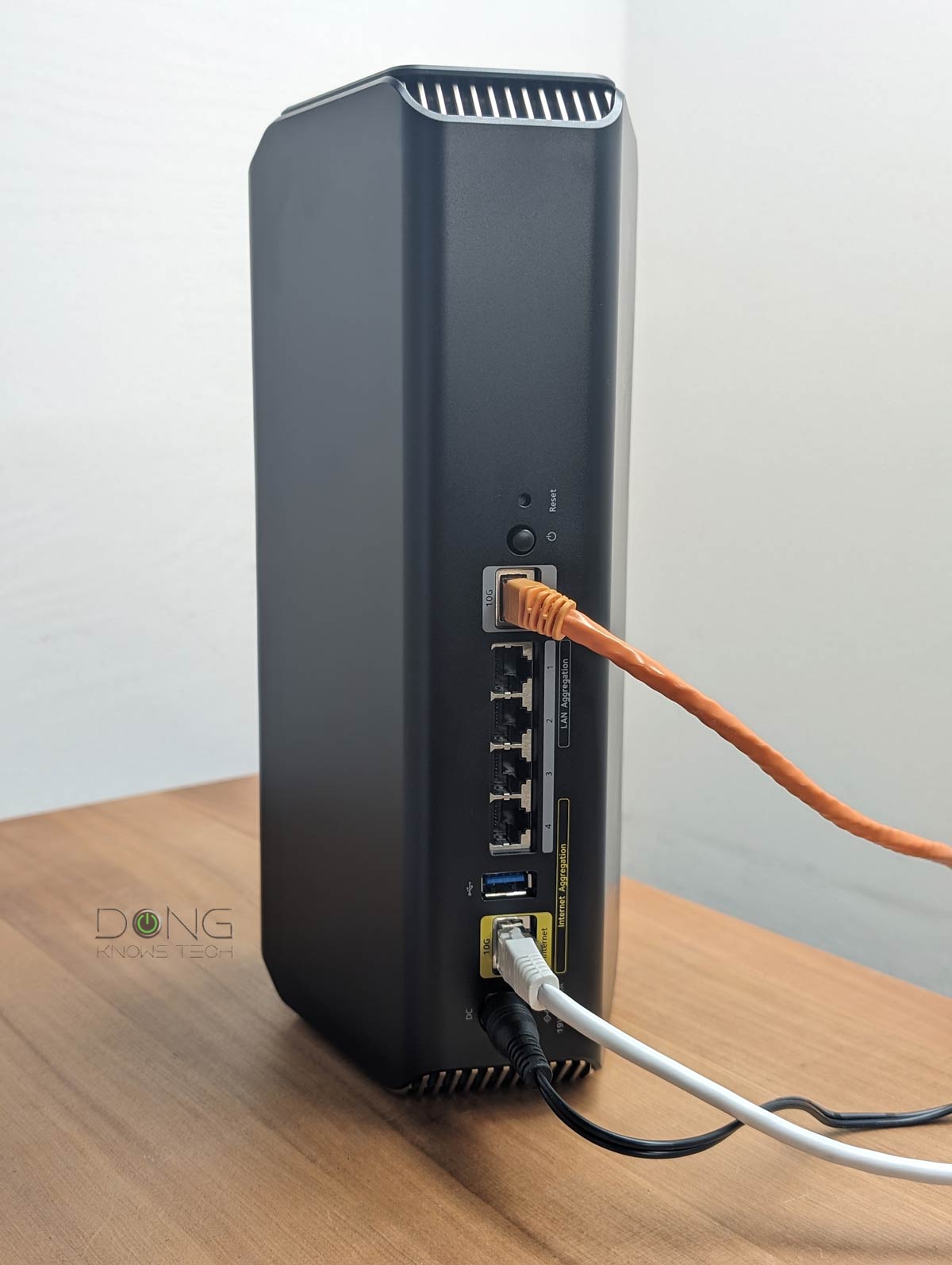
First Nighthawk router that’s supposedly mesh-ready
Netgear told me that the RS700S supports Wi-Fi EasyMesh, the same mesh approach used in the company's MK83 and MK63 systems.
Specifically, you can use multiple RS700S units together to form a Wi-Fi system, similar to the case of Asus AiMesh or Synology Mesh. Additionally, the new router will (supposedly) work with any (third-party) hardware that's Wi-Fi EasyMesh certified. That's the idea, anyway.
Wi-Fi EasyMesh in brief
Wi-Fi EasyMesh is Wi-Fi Alliance's certification program, first announced in early 2020, that aims to simplify the building of mesh systems by creating universal mesh protocols. The idea is any Wi-Fi EasyMesh-certified hardware from any vendor will work with one another to form a seamless Wi-Fi mesh system. Per the organization, here are the highlights of EasyMesh:
- Increased network capacity: Supports more simultaneous services and higher realized throughput when operating in Wi-Fi 6 and Wi-Fi 6E
- Flexible design: Allows for best placement of multiple APs to provide extended coverage
- Easy setup: Delivers seamless, secure device onboarding and configuration using QR codes through Wi-Fi Easy Connect technology
- Network intelligence: Advanced diagnostics for Wi-Fi 6 capabilities through Wi-Fi Data Elements facilitate service provider support and respond to network conditions to maximize performance
- Effective service prioritization and Quality of Service (QoS) support: Capability to prioritize low latency applications when needed and guide devices to roam to the best connection and avoid interference
- Scalability: Enables the addition of Wi-Fi EasyMesh APs from multiple vendors
The new program's adoption has proven slow. By late mid-2023, only Netgear and TP-Link had joined the movement. The former uses it in its Nighthawk purpose-built mesh family, first represented by the MK63 and MK83—none is a standalone router. TP-Link, on the other hand, started to transition its OneMesh—available in standalone routers—into TP-Link EasyMesh in August 2022. (In real-world trials, the EasyMesh hardware of TP-Link and Netgear, so far, has yet to work with each other.)
Understandably, both TP-Link and Netgear recommend their own hardware in an EasyMesh setup.
Generally, we need the hardware of at least two vendors working together to know Wi-Fi EasyMesh is universal. But then, things can get complicated in terms of liability or tech support. If a mixed Wi-Fi EasyMesh system is not working as expected, it's hard to know which hardware vendor is at fault, and consumers might be stuck between two networking companies that point fingers at each other.
However, in my testing, there was no indication that the router's mesh feature was ready. There was no section within its web user interface for the Nighthawk mobile app suggesting the use of multiple units to form a mesh system.
I used a single unit for this review, and the TP-Link BE550, another EasyMesh router I had with me, didn't work with it. So, I'd say support for Wi-Fi EasyMesh was not available during my time with the router, though that could be changed via firmware update.
Netgear RS700S: A familiar Nighthawk router with standard network settings and a thin feature set
Despite its support for Wi-Fi 7 and dual 10Gbps ports, the RS700S remains a standard router, similar to others in the same family. You can expect the same set of features and settings as that of Netgear's previous Wi-Fi 6 and 6E Nighthawk routers.
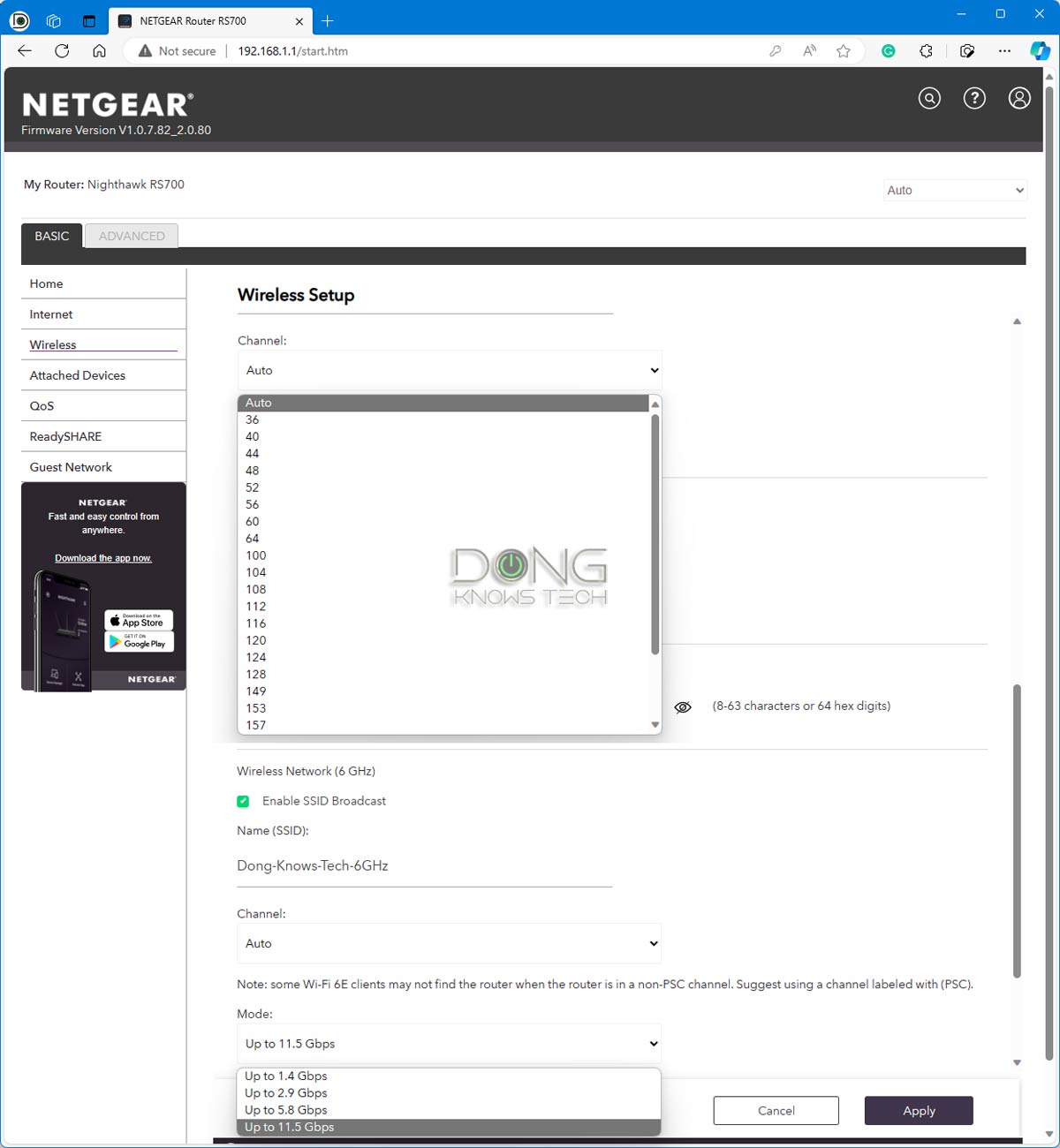
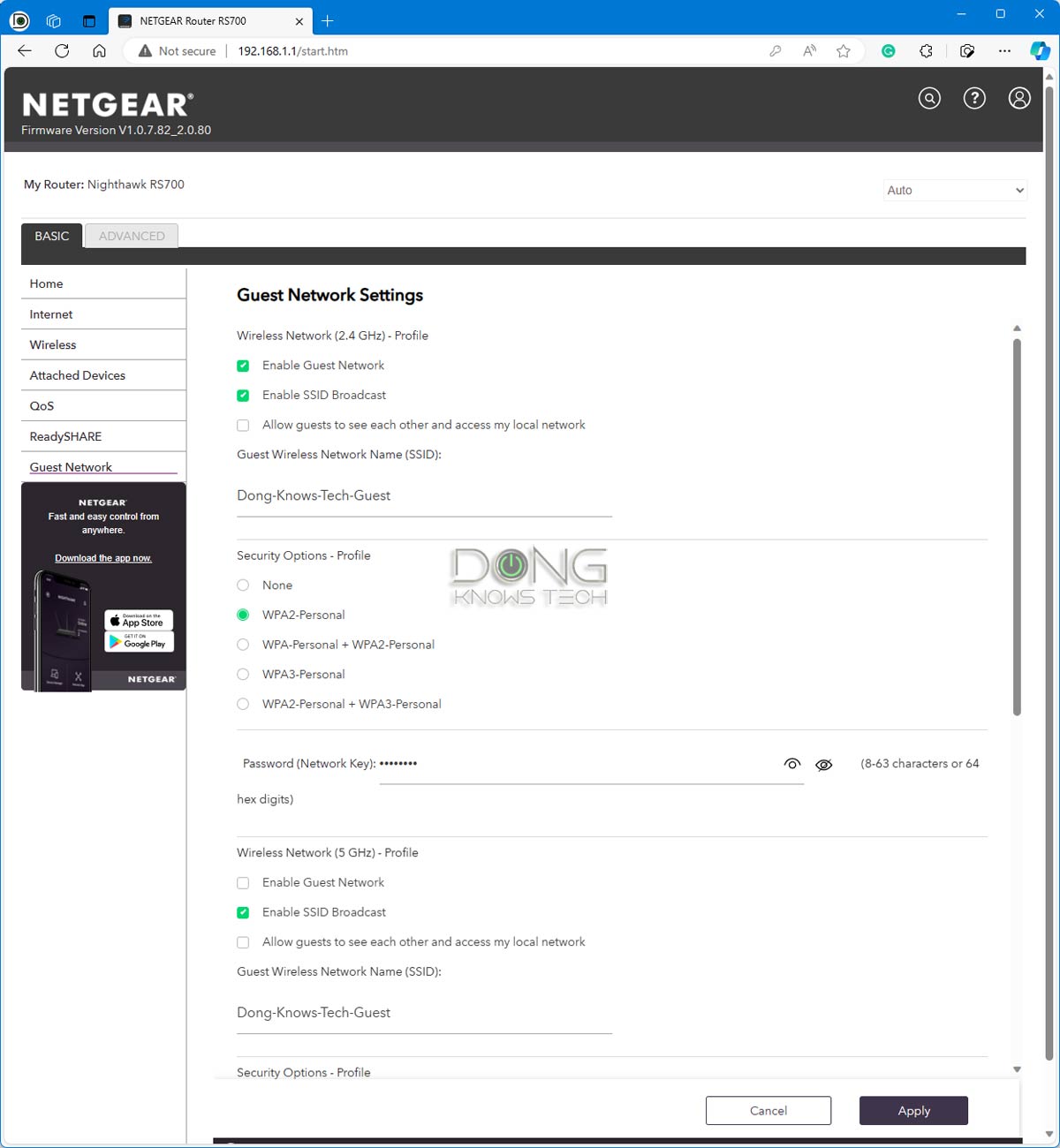
The router has a full web user interface accessible via the default IP address, 192.168.1.1. The first time you access this interface, you have to get past Netgear's Nighthawk mobile app coercion by clicking on the link at the bottom of the web page.
After that, you need to create a new admin password, set up the Wi-Fi SSIDs, and access the router's standard network settings. Things are generally self-explanatory. You can expect the following in all standard Nighthawk routers:
- Standard LAN configuration: The customization of the DHCP server with its IP address pool. In most cases, you can just leave this in the default settings.
- Standard WAN settings: The router can connect to the Internet via a dynamic IP address (the default) or a static IP address.
- IP reservation and port forwarding: These settings allow you to give a local client a specific IP address and forward a particular port to it. They are helpful in setting up a server within the local network.
- Main Wi-Fi network: You can choose between Smart Connect or one SSID for each band. Each band includes in-depth customization, with the option to pick the performance grade "up to" a certain speed- there's no reason not to pick the highest number (default).
- Guest Wi-FI network: One SSID for each band. You have the option to make the SSID not isolated from the primary network.
Additionally, the router comes with the following noteworthy free features:
- VPN Service: The support for the Open VPN protocol, including downloads for VPN clients for Windows, macOS, and smartphones.
- Dynamic DNS: The support for DDNS using Netgear, NoIP, or Dyn as the domain provider.
- QoS: A simple Quality of Service feature that uses an online database to prioritize the traffic without any users' input other than turning it on or off.
- Traffic Meter: This is a useful bandwidth management tool that allows users to set download or upload limits and manage the monthly data cap.
It's worth mentioning that Netgear consumer-grade routers do not offer web-based remote management. This feature was initially available in previous Nighthawk routers until it was quietly killed to encourage users to use the mobile app.
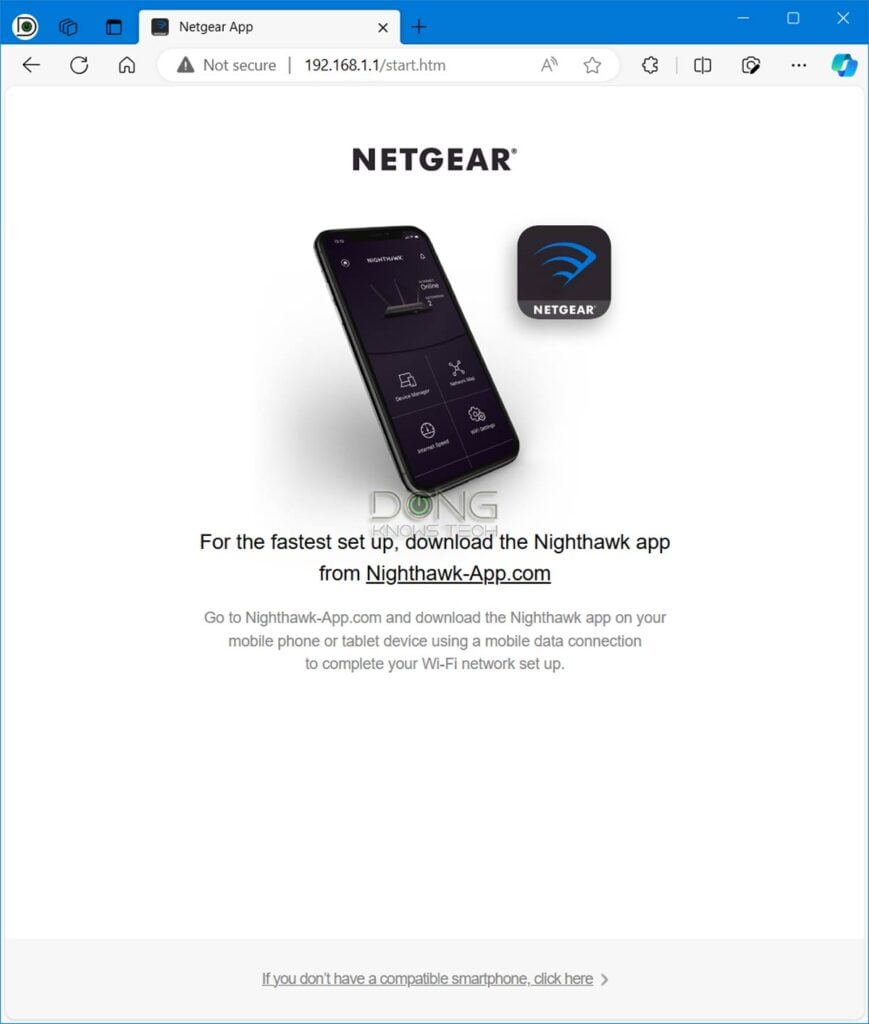
That said, to manage your network remotely, you must use the Nighthawk app. This app also facilitates the activation and management of the included year-long Netgear Armor protection feature, which costs $99.99/year afterward. Additionally, there's another $69.99/year Parental Control add-on.
To use the Nighthawk app, you must sign up for a login account with Netgear—you manage the home network remotely via the vendor's server. Additionally, the app has very little access to the standard settings and features mentioned above, making it tricky to manage a Nighthawk router remotely. For example, you must use the web user interface to manage port forwarding or IP reservation, but the interface can't be accessed remotely.
Netgear and your privacy
Registering the hardware with a D-Link Cloud account generally means it's always connected to the vendor, which translates into inherent privacy risks.
Here's the Taiwanese networking vendor's Privacy Policy.
Managing your home network via a third party is generally not a good idea, but privacy is a matter of degree. Data collection and handling vary vendor by vendor.
That said, while you can get a lot of things done with a Netgear Nighthawk router, advanced users will find those of Asus, TP-Link, Synology, or Ubiquiti much better alternatives in terms of features and usability. The fact their web user interface is accessible via the Internet alone is enough to make things night and day in terms of management.
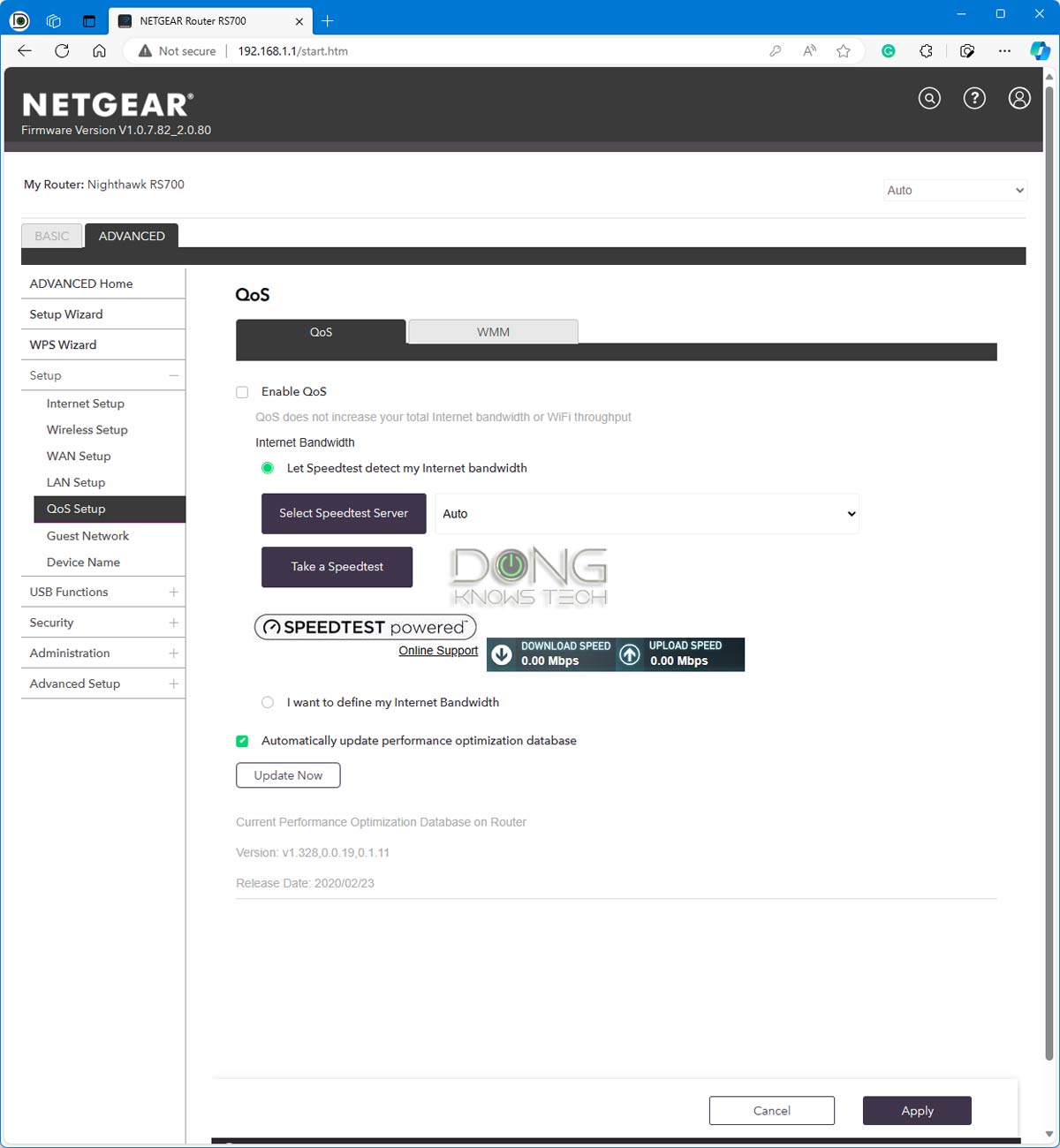
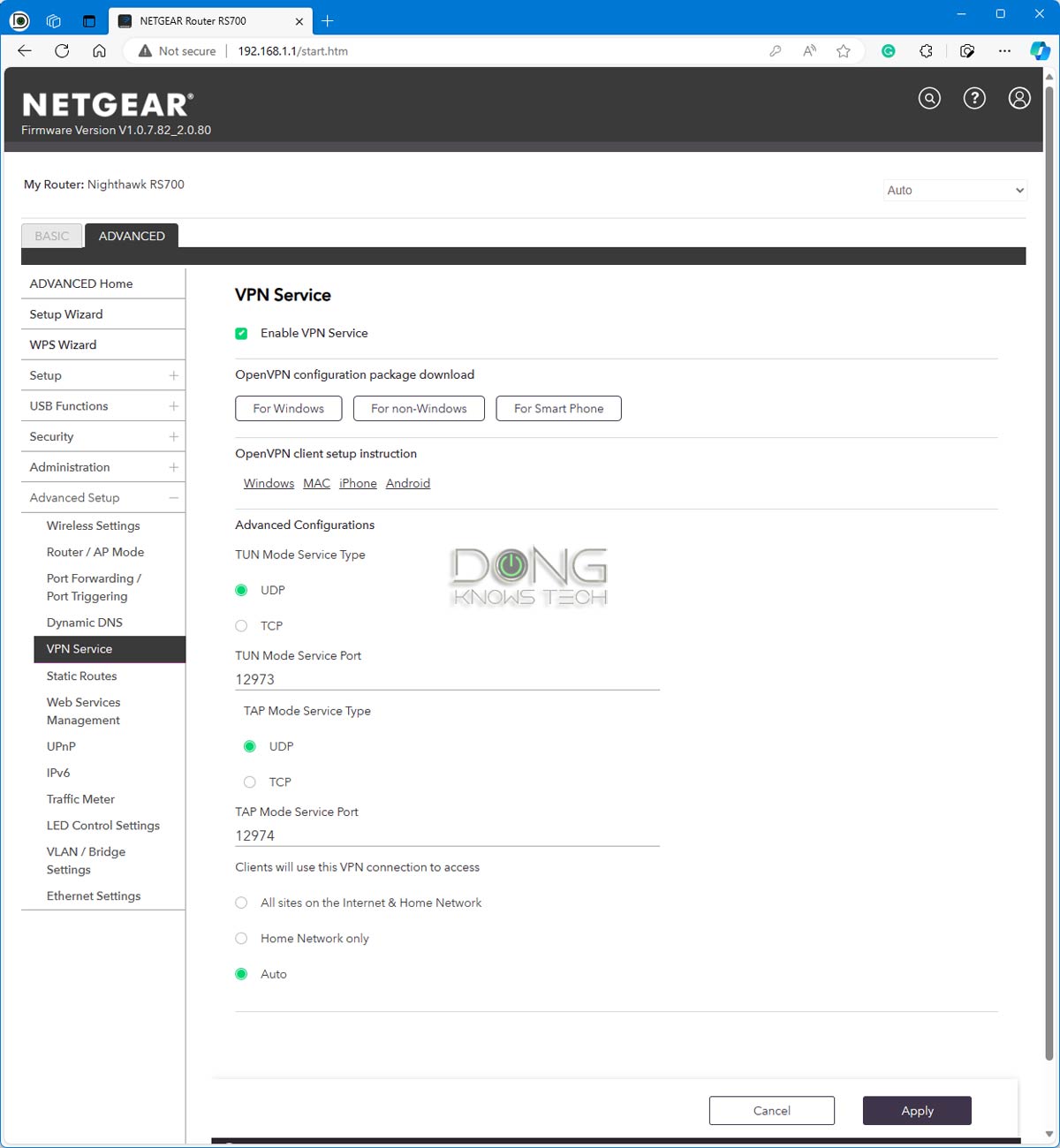
Netgear Nighthawk RS700S: Excellent performance
What the Netgear RS700S lacks in features, it more than makes up for in performance.
For this review, I used a Netgear RS700S for over a week and was happy with it. With the latest firmware, the router worked flawlessly with my Wi-Fi 7 clients as well as those of older standards.
The router passed my standard 3-day stress test without any disconnection, and I didn't run into any issues during the entire real-world trial.
Fast Wi-Fi and wired real-world rates
In terms of Wi-Fi performance, the new router topped the chart with hosting Wi-Fi 7 clients.
It's worth noting that the RS700S was the first standalone router I tested after Wi-Fi 7 had been finalized. That fact might have contributed to its excellent performance. And, like the case of the previous record-holder, the Asus RT-BE96U, its top-spot status might not last long, considering there are many more high-end Wi-Fi routers on the horizon.
The router also did well with older devices, though it was not necessarily the fastest. It was similar to previous broadcasters.
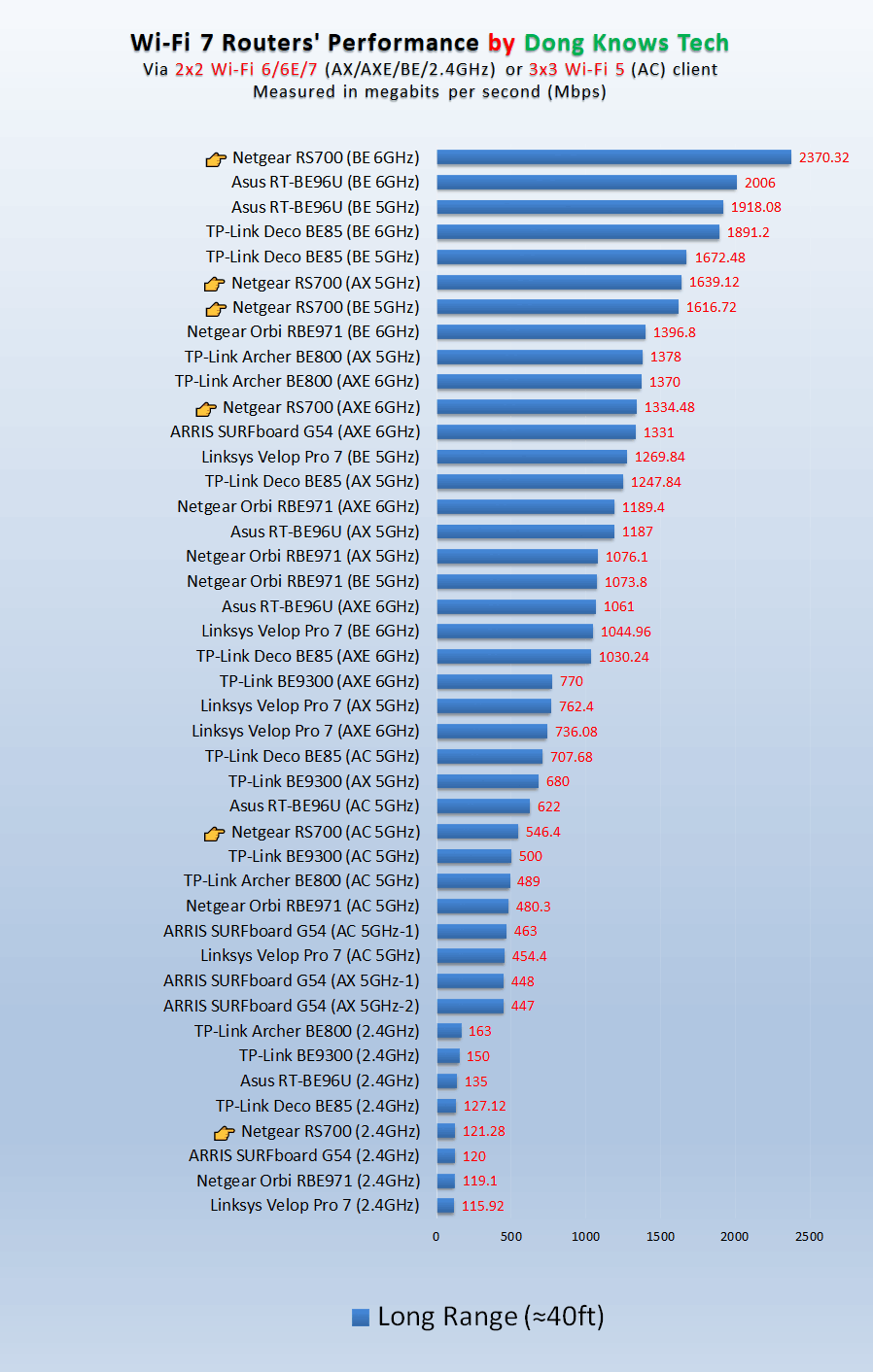
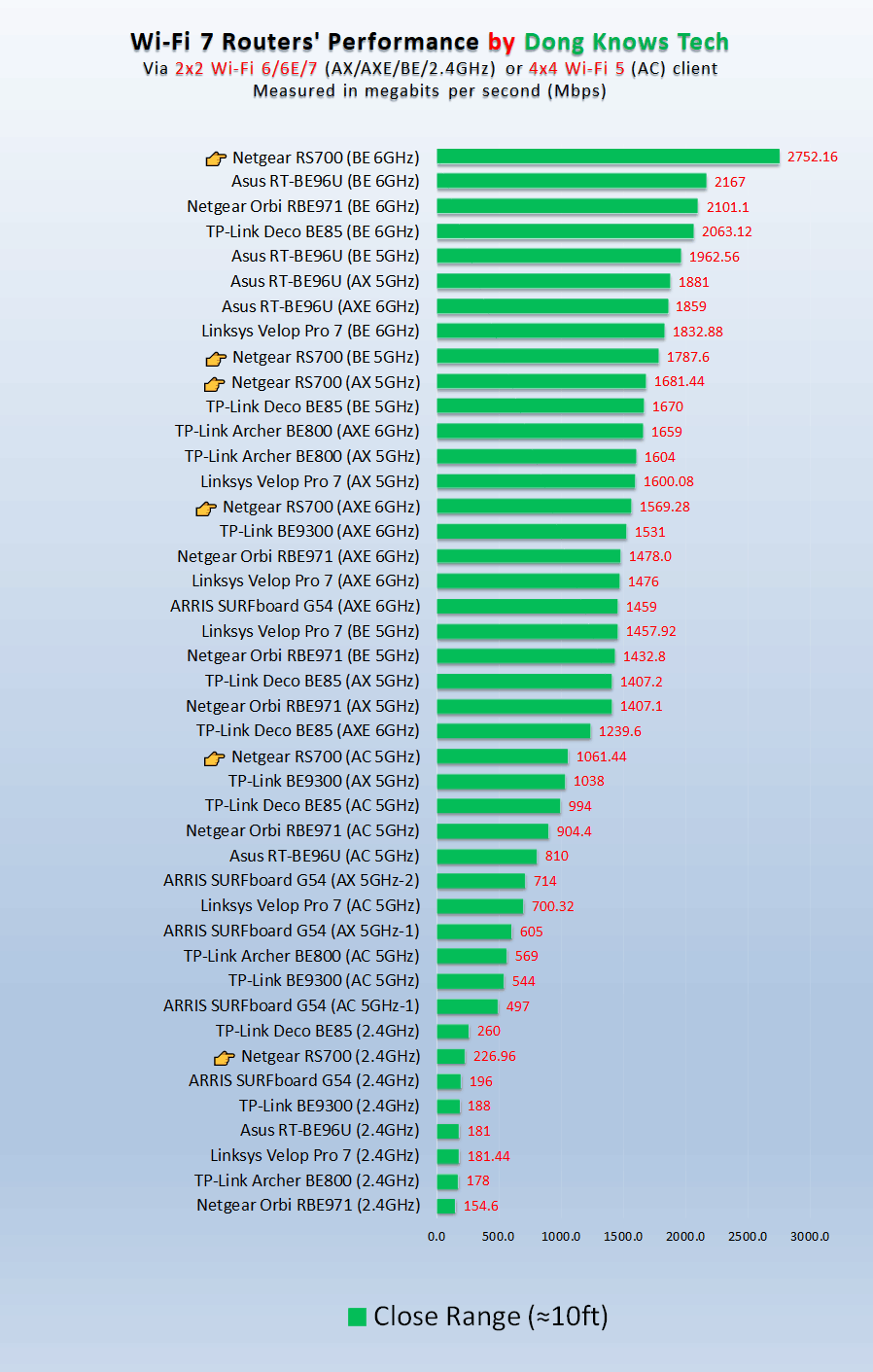
As for range, Netgear's claim of up to 3500 ft2 (325 m2) was a bit of a stretch. But the RS700S indeed had excellent coverage, about the same as that of the Asus RT-BE96U or any high-end Wi-Fi 6E broadcasters.
It's hard to quantify the range, but when placed in the center, it can cover a home of around 2500 ft2 (232 m2) without thick walls. Your mileage will vary depending on your expectations of the real-world data rates.
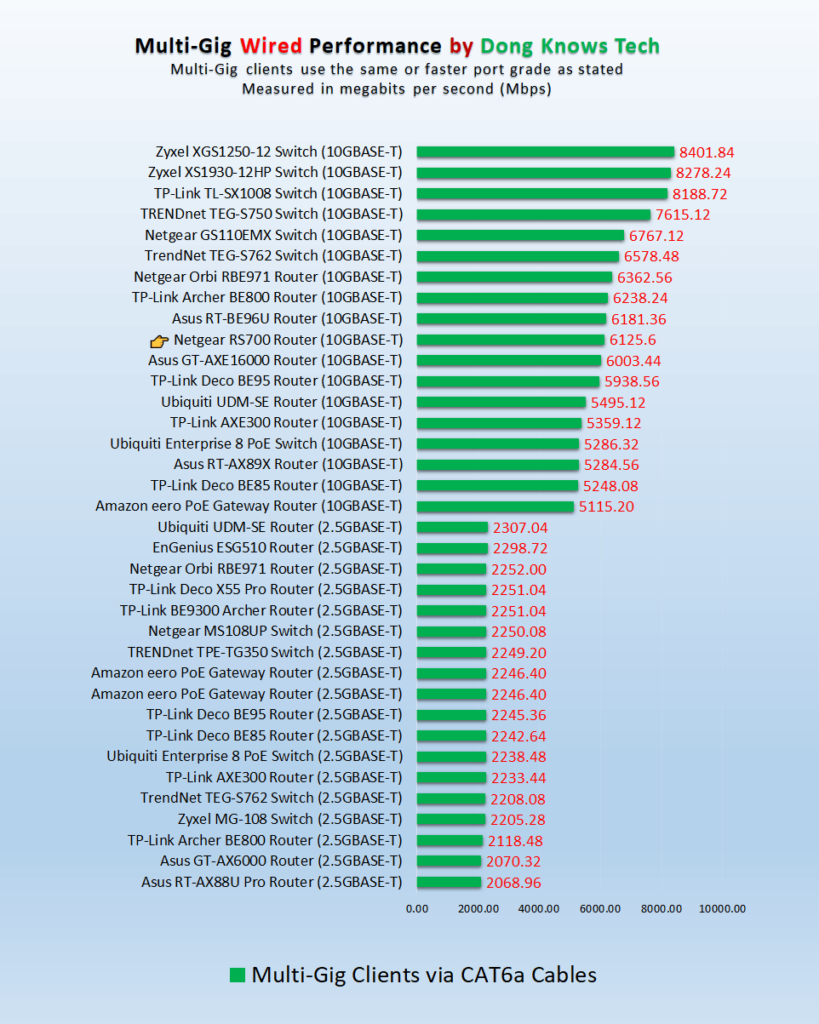
The Netgear RS700S did well with wired clients, too. I tested its 10Gbps ports the way I do Multi-Gig switches, and it averaged over 6Gbps of sustained real-world speed, slightly faster than most other routers with the same ports.
Good network-attached storage performance
Netgear Nighthawk routers, when equipped with a USB port, can function as an excellent mini NAS server. Besides sharing data, they can also work as a good DLNA media server.
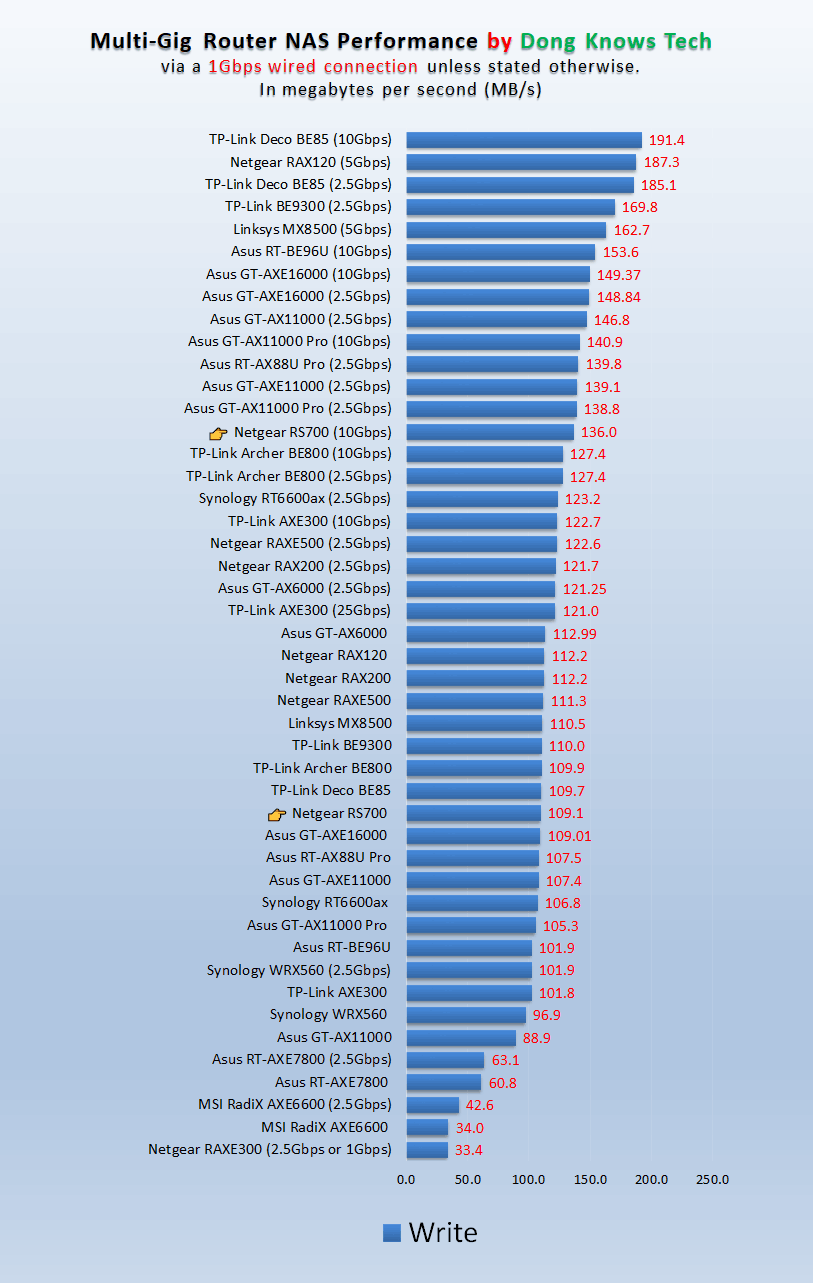

That was the case of the RS700S. I tested it with a My Passport SSD, and the router did quite well in real-world throughput rates. The read performance of close to 250MB/s was fast enough for most casual home network storage needs, sufficient for you to try things out before getting a serious, dedicated NAS server.
Other than that, the Netgear RS700S ran cool and was utterly silent during my testing. That alone was more than enough to make up for its relatively large physical size.
Netgear Nighthawk RS700S' Rating
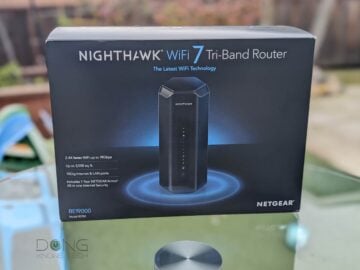
Pros
Top-tier tri-band specs with Wi-Fi 7 support
Two 10Gbps Multi-Gig ports
Robust web interface, helpful (optional) mobile app
Practical fan-less design; runs cool and quiet
Cons
Only two Multi-Gig ports; no standard Remote Management via Dynamic DNS
Online protection and Parental Controls require the Nighthawk mobile app and premium subscriptions
Conclusion
At the current street price of around $650, the Netgear Nighthawk RS700S Wi-Fi 7 router is an excellent buy for those needing a single broadcaster in the house that, among other things, meets the "wife acceptance" requirement. It's one of the best Wi-Fi 7 routers you can get today.
If you want more features and don't mind the bulkiness, the RT-BE96U will make an excellent alternative.
Now that Wi-Fi 7 has been finalized, keep in mind that these two will only get better over time via firmware updates, and their price will only get lower as more affordable hardware becomes available. But if you can't wait, both are among the safe options to bring home today.
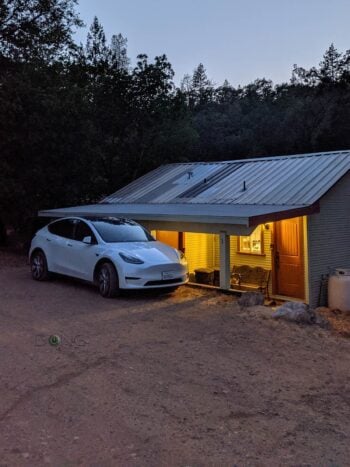
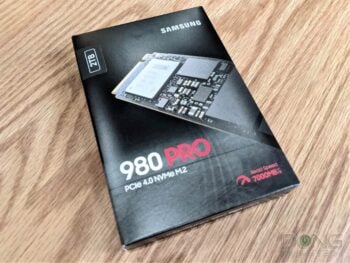
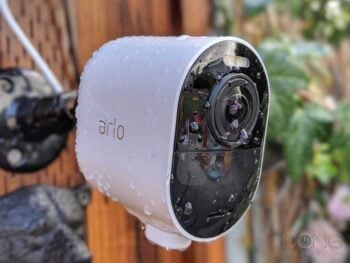
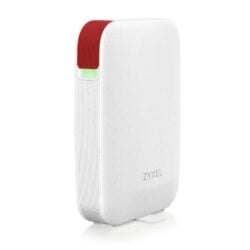
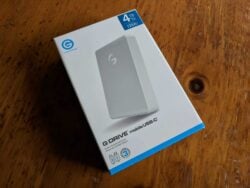
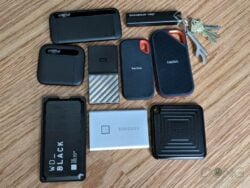

I noticed there’s no WPS button on this router nor is there any mention of it. What’s your take? Is this spec going away, did Netgear forget to add it, etc.? I’m surprised there’s no mention as it’s been a widely used protocol for many years. Most routers have a WPS button, and Netgear has it on their previous Wi-Fi 6 Nighthawk routers as well.
It’s a soft button within the Advanced->WPS Wizard section of the web user interface, Jaysin—screenshot in this section of the review. WPS is considered not secure so it’s put to limited use in most routers.
Does it support wireguard vpn client?
Read the review, John.
Does the 10GB port work with a 2.5GB switch?
Yes, that’s how the Multi-Gig standard works, Carl.
For example I bought a Arris G36 which has one 2.5GB port. That port does not work with a switch. Only the gigabit ports work with the switch.
According to the manual for the RS700, it says that the 10gig LAN and WAN ports are only compatible with One RJ-45 port compatible with 10GBASE-T, 1000BASE-TX, 100BASE-T and 10BASE-T.
Oddly enough, on page 17, it says that the 10 gig LAN port works with 5 gig, 2.5 gig, and 1 gig, so maybe it truly does downgrade to 5 and 2.5 gig.
Hi Dong, thank you for another great review.
As you know, I’ve been looking at various mesh router options, from the Asus ZenWiFi ET12 to the Deco BE85 to possibly the soon-to-be-released Asus ZenWiFi BQ16 Pro.
Given this router’s amazing range, would this be a good single-router option for a relatively modern, 3,500 sq. ft. multi-story home? Also, in a home with a mixture of different Wi-Fi devices (iPhones, iPads, Nest Battery Cams, Lutron lights, etc.), do you prefer to set up a home router with SmartConnect and a single SSID or have individual bands with multiple SSIDs? As always, thank you for your guidance and support.
Given? Amazing range? Are we living in the same world? Did you actually read the review, Kelly? Give it a serious read and rephrase your question, please. 🙂
And seriously, please respect the comment rules above. 🙏🏼
Yes, I read your review. Twice. I picked up the amazing range info from a YouTube reviewer. Sorry, I should have mentioned that.
{…}
I don’t address stuff you’ve consumed elsewhere, Kelly. There’s no amazing range with Wi-Fi routers, just range. More here. I mentioned this particular router’s Wi-Fi converge in the performance section which you’ve read twice.
Fair enough. What about my second question, which is in a home with a mixture of different Wi-Fi devices (iPhones, iPads, Nest Battery Cams, Lutron lights, etc.), do you prefer to set up a home router with SmartConnect and a single SSID or have individual bands with multiple SSIDs?
Check out this post, Kelly.
Hi Dong
Curious how soon do you think you might be able to further test this router? I think the firmware to support Multi-Link is not yet available, so I wouldn’t be surprised if you are waiting until such time to minimize review time.
I think it would be interesting to compare some range and speed to some single device Wifi 6E/6 router/mesh, given lack of available Wifi 7 clients and many people are not sure spending extra $ for W7 right now is worth it (other than being future ready). For example, in most homes, would this RS700S show meaningful range and speed improvements in its current use scenarios (mainly 5 & 2.4) over let’s say, Asus XT12/ET12 or Deco XE200 — which based on your testing, seem generally like powerful “lifestyle” options for many homes.
Oh, one minor spec correction – Memory: 2GB RAM
Likely after the holidays, Chip. It’s been hectic. I’d say that the range will likely be the same as other high-end Wi-Fi 6 or 6E router. Until AFC is avaible, I can’t see how the range could be better. And AFC is only for the 6GHz band. More here.
“If you wonder why it doesn’t feature a faster USB standard, such as USB 3.2 Gen 2 (10Gbps), to accommodate its 10Gbps ports and faster Wi-Fi speeds, that’s the Wi-Fi chip’s fault. Per Netgear, the RS700 is powered by Broadcom BCM67263/26 Wi-Fi 7 chips, first announced in April 2022”
So, USB bus speeds are limited by a dated Broadcom chipset ..disappointing. Mr. Ngo, do know of any standalone Wifi-7 routers on the market (or upcoming) that offer a more recent chipset supporting a USB 3.2 Gen 2×2 port?
Nope. I don’t think there’ll be any soon.
About the RS700 5GHz support Sub-band in Taiwan?
I wonder if it can be placed horizontally without affecting wifi performance
Yes, Perry. You just need to leave it out in the open.
Hello,
I am looking to get a new wifi 7 router, but I don’t have 10G internet. I rather use 10G ports for lan so I can transfer large files to my HTPC. Will this router let me pick what the 10G ports do? I think my old netgear router let me pick what the SPF+ was used for, but this is a different setup. If it doesn’t is there a wifi 7 routher that would? I just really need two 10G lan ports from my PC to HTPC. Thank you!
No, Jonathan, I don’t think so. You’ll need a 10Gbps switch, or wait for a different router. There will be more. This one is not even available yet
It’s actually available now! The Netgear page for it has moved from “Preorder” to “Add to Cart”, and my preorder was shipped yesterday and is expected to arrive tomorrow.
Great news!
Hi Dong any idea when Wifi 7 routers will be available in the UK? Thanks.
I don’t, JD, but likely by early next year. Until, then, you’re not missing out on munch.
Do you know if the power adapter (on the power outlet end) will be a big/bulky one like previous Netgear routers, or will it be a two part power adapter where the end that connects to the power outlet is like a desktop PC power cable?
Your guess is as good as mine for now. I’ll generally include a photo of the power adapter when that’s possible.
Thanks! Was hoping for it to be the latter so it could fit my UPS without taking up the spot of other outlets. Can’t wait for your review, which I assume will be later this month when the device releases.
Do you know if Netgear already have a USB Wi-Fi 7 adapter? Or any brand in that case? There are very few devices right now that will work with Wi-Fi 7.
There’s no device that supports Wi-Fi 7 yet, Manny. More in this post.
I am curious if the Easy Mesh functionality is something that could be enabled on older devices (e.g. WIFI 6 equipment)? It’s obviously only be announced now after having the standard sorted in 2022, but curious if there is any technical limitation that stops it from being enabled via an update on older equipment.
Technically, that’s possibly, DK, but there’s no reason why any vendor should invest in that — it’s only good for their competitors. So the soft answer is no. It’s wishful thinking. The hard answer is I don’t know.
Pity to see the Easy Mesh functionality doesn’t appear to be available at launch. If this does get enabled at some time, please consider providing an update along with some test results.
I’d not count on EsayMesh, DK. More here.
Is it backwards compatible with Wifi 6e? IE if I buy this and only have Wifi 6e compatible clients will they be able to take advantage of speeds up to 6E or only Wifi 6 (assuming they are close enough, etc)?
And will the mesh feature have a dedicated backhaul like an Orbi?
Read the post, Dave.
what is the best recommended high speed VPN router comparable to this Netgear7? I am in the country on acreage and need to install a wifi mesh system.
I don’t know, Richard. I don’t test VPN performance since it’s impossible to do that consistently —- the speed depends on both ends’ Internet connection. Generally, don’t count VPN as something you use for super demanding traffic, especially with home-grade hardware. And in most cases, you don’t need crazy traffic with VPN. More on VPN here.
I’m curious if its backwards compatible with the older easy mesh devices or only with the wifi 7 devices.
It’s unclear, Ronnie. But even if that’s possible, it’s not a good idea to mix Wi-Fi standards in a mesh and in the case of Wi-Fi 7, that’d negate all of its benefits.